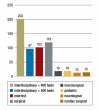Nosocomial infections and multidrug-resistant organisms in Germany: epidemiological data from KISS (the Hospital Infection Surveillance System)
- PMID: 21373275
- PMCID: PMC3047718
- DOI: 10.3238/arztebl.2011.0087
Nosocomial infections and multidrug-resistant organisms in Germany: epidemiological data from KISS (the Hospital Infection Surveillance System)
Abstract
Background: More than 800 hospitals and 586 intensive care units (ICUs) in Germany currently participate in a nationwide surveillance system for nosocomial infections (Krankenhaus-Infektions-Surveillance-System, KISS), which collects data on the frequency of nosocomial infections and pathogens and on the appearance of pathogens of special epidemiological importance.
Methods: Data were collected from ICUs regarding lower respiratory tract infections, primary sepsis, and urinary tract infections and on the temporal relation of these types of infection to the use of specific medical devices (invasive ventilation, central venous catheters, and urinary catheters). On the basis of these data, device-associated infection rates (number of infection per 1000 device days) were calculated for different types of ICUs. KISS also collected data on all ICU patients colonized or infected with selected multidrug-resistant organisms (MDRO) and on all hospitalized patients with methicillin-resistant Staphylococcus aureus (MRSA) and Clostridium difficile-associated diarrhea (CDAD).
Results: Device-associated infection rates ranged from 0.9 to 9.6 per 1000 device-days, depending on the type of infection and the type of ICU. An extrapolation from these figures yields an estimate of 57 900 ICU-acquired infections occurring in Germany each year. The most common MDRO in ICU patients is MRSA. The frequency of MRSA has remained stable in recent years, but that of other MDROs among ICU patients is rising. Hospitalized patients are twice as likely to acquire CDAD as they are to acquire MRSA.
Conclusion: Nosocomial infections are common in the ICU. The percentage of ICU patients with MDRO is low, but rising. Future preventive strategies must address this development.
Figures





Comment in
-
Correspondence (letter to the editor): Non-albicans Candida species.Dtsch Arztebl Int. 2011 May;108(18):320. doi: 10.3238/arztebl.2011.0320a. Epub 2011 May 6. Dtsch Arztebl Int. 2011. PMID: 21629516 Free PMC article. No abstract available.
References
-
- Geffers C, Sohr D, Gastmeier P. Mortality attributable to hospital-acquired infections among surgical patients. Infect Control Hosp Epidemiol. 2008;29:1167–1170. - PubMed
-
- Aranaz-Andres JM, Aibar-Remon C, Vitaller-Murillo J, et al. Incidence of adverse events related to health care in Spain: results of the Spanish National Study of Adverse Events. J Epidemiol Community Health. 2008;62:1022–1029. - PubMed
-
- Pittet D, Tarara D, Wenzel RP. Nosocomial bloodstream infection in critically ill patients. Excess length of stay, extra costs, and attributable mortality. Jama. 1994;271:1598–1601. - PubMed
-
- Beyersmann J, Gastmeier P, Grundmann H, et al. Use of multistate models to assess prolongation of intensive care unit stay due to nosocomial infection. Infect Control Hosp Epidemiol. 2006;27:493–499. - PubMed
-
- Rioux C, Grandbastien B, Astagneau P. Impact of a six-year control programme on surgical site infections in France: results of the INCISO surveillance. J Hosp Infect. 2007;66:217–223. - PubMed
Publication types
MeSH terms
LinkOut - more resources
Full Text Sources
Medical

